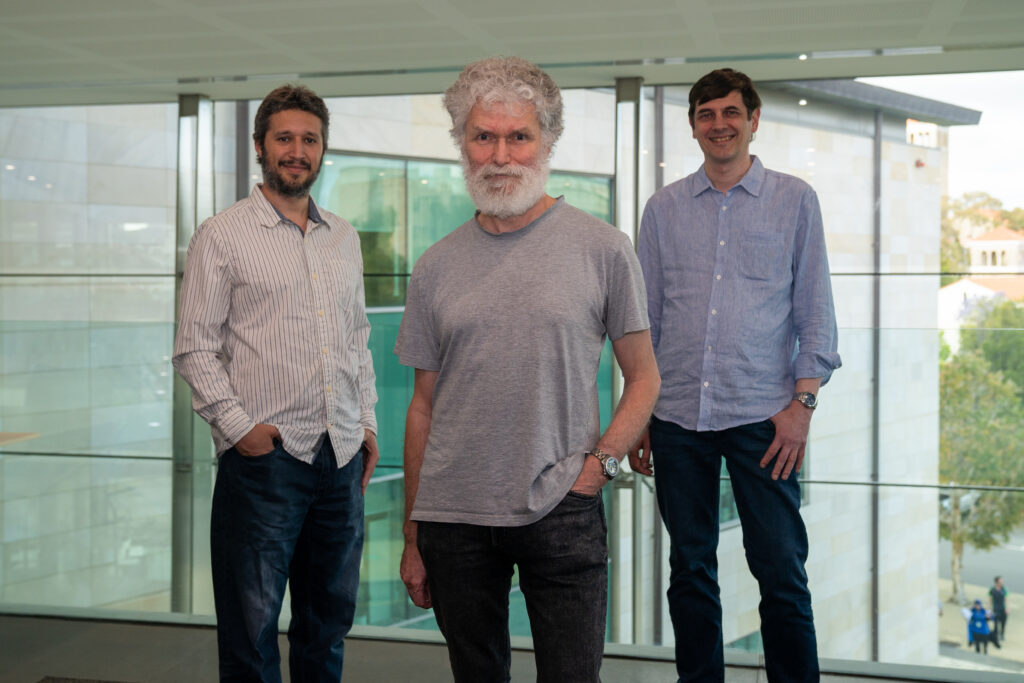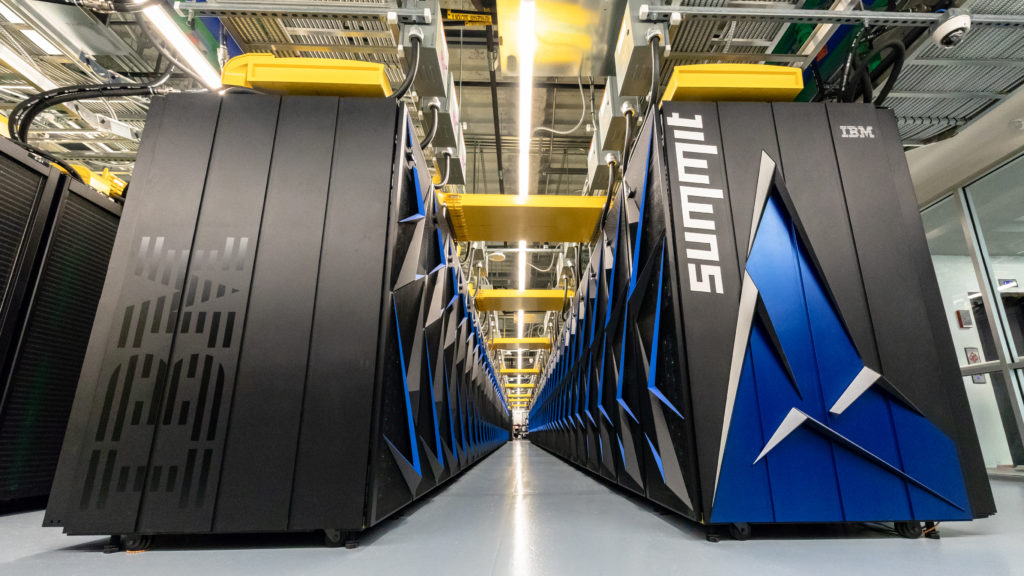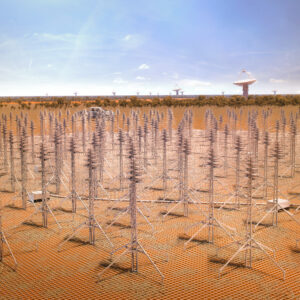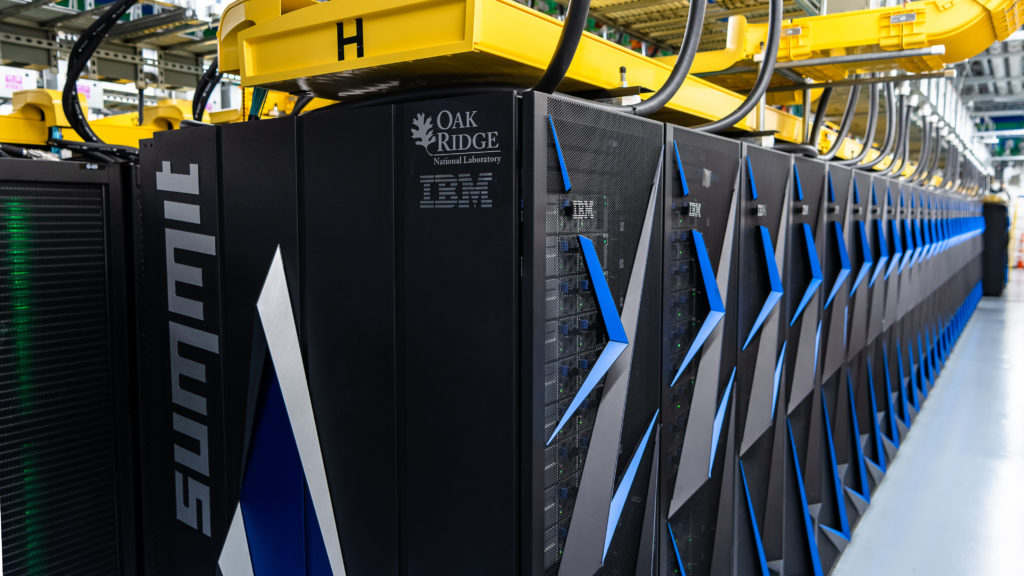An international team led by The University of Western Australia was one of six finalists for the prestigious Gordon Bell Prize for outstanding achievement in high-performance computing.
The group was shortlisted for the award—commonly referred to as the ‘Nobel Prize of supercomputing’—for their work developing data pipelines for the future Square Kilometre Array (SKA) telescope and testing them on the Summit supercomputer.

Rodrigo Tobar, Prof. Andreas Wicenec and Markus Dolensky (L-R) from ICRAR’s Data Intensive Astronomy team. Credit: ICRAR/UWA
The team used Summit—the world’s fastest supercomputer at the time—to process simulated observations of the early Universe ahead of the telescope being built in Western Australia and South Africa.

Summit — Oak Ridge National Laboratory’s 200 petaflop supercomputer. Credit: Oak Ridge National Laboratory.

Close-up artist rendition of the SKA-Low aperture array and ASKAP dishes in Australia. These dipole antennas, which will number in their hundreds of thousands, will survey the radio sky in frequencies as low at 50Mhz. Credit SKAO.
International Centre for Radio Astronomy Research (ICRAR) director of Data Intensive Astronomy Professor Andreas Wicenec, who is based at UWA, said construction of the billion-dollar SKA project was expected to begin next year.
“When complete, the SKA will be the world’s largest radio telescope and one of the world’s largest data generators,” he said.
“The low frequency part of the telescope alone is set to have more than 130,000 antennas in its initial phase, generating around 550 gigabytes of data every second.”

Composite image of the SKA-Low telescope in Western Australia. The image blends a real photo (on the left) of the SKA-Low prototype station AAVS2.0 which is already on site, with an artists impression of the future SKA-Low stations as they will look when constructed. These dipole antennas, which will number in their hundreds of thousands, will survey the radio sky in frequencies as low at 50Mhz. Credit ICRAR and SKAO.
To process data on this scale, Professor Wicenec said the team used a cluster of 4560 computers, featuring 27,360 high-end GPUs and 191,520 CPU cores.
“The whole simulation ran for about three hours at an average of 64.9 PFLOPs, or 64,900,000,000,000,000 mathematical operations, per second,” he said.
“The highest writing data rate we achieved was 925GB a second, and the effective throughput of the complete simulation was about a factor of two better than what is required by the SKA.”
Professor Wicenec said the team was surprised but thrilled to be a finalist in the Gordon Bell Prize.
“I didn’t expect it at all given the calibre of previous winners and the highly-sophisticated nature of their projects,” he said.
“We didn’t have the Gordon Bell Prize in mind when we set out to do this work, so it’s fantastic to be recognised for the remarkable performance the multinational team achieved.”
The project was a collaboration between ICRAR, Oak Ridge National Laboratory (ORNL) and Shanghai Astronomical Observatory (SHAO).
The group’s nomination for the award was supported by SKA director general Professor Philip Diamond and US National Radio Astronomy Observatory director Dr Tony Beasley.
The ACM Gordon Bell Prize was established in the 1980s with a nominal $100 prize for anyone who could overcome Amdahl’s Law and demonstrate that parallel computing made sense.
Today, the prize continues to track the progress of parallel computing, while rewarding innovation in applying high-performance computing to science, engineering, and large-scale data analytics.
In previous years, finalists have presented their work in person ahead of an award ceremony at the annual SC supercomputing conference.
In 2020, the conference and award ceremony were held virtually, with the prize ultimately awarded to a nine-member team, drawn from Chinese and American institutions, for their project, “Pushing the limit of molecular dynamics with ab initio accuracy to 100 million atoms with machine learning.”
See also: World’s fastest supercomputer processes huge data rates in preparation for mega-telescope project
https://vimeo.com/icrar/gordonbell
More Information:
Summit
The U.S. Department of Energy’s Oak Ridge National Laboratory (ORNL) unveiled Summit as the world’s most powerful and smartest scientific supercomputer on June 8, 2018.
With a peak performance of 200,000 trillion calculations per second—or 200 petaflops, Summit is eight times more powerful than ORNL’s previous top-ranked system, Titan. For certain scientific applications, Summit will also be capable of more than three billion billion mixed precision calculations per second, or 3.3 exaops. In addition to scientific modelling and simulation, Summit offers unparalleled opportunities for the integration of AI and scientific discovery, enabling researchers to apply techniques like machine learning and deep learning to problems in human health, high-energy physics, materials discovery and other areas.
ICRAR
The International Centre for Radio Astronomy Research (ICRAR) is a joint venture between Curtin University and The University of Western Australia with support and funding from the State Government of Western Australia.
Oak Ridge National Laboratory
The U.S. Department of Energy’s (DOE) Oak Ridge National Laboratory (ORNL) is the nation’s largest multi-program science and technology laboratory. ORNL’s mission is to deliver scientific discoveries and technical breakthroughs that will accelerate the development and deployment of solutions in clean energy and global security.
Shanghai Astronomical Observatory
Shanghai Astronomical Observatory (SHAO), is an astronomical observatory in Shanghai. It has a long history of astrometry, and also operates the Sheshan 25-m radio telescope as part of the Chinese Very Long Baseline Interferometry (VLBI) array and the European VLBI Network (EVN).
Contacts:
Dr Andreas Wicenec — ICRAR / UWA
Ph: +61 8 6488 7847 E: Andreas.Wicenec@icrar.org
Pete Wheeler — Media Contact, ICRAR
Ph: +61 423 982 018 E: Pete.Wheeler@icrar.org
Jess Reid — Media Contact, UWA
Ph: +61 8 6488 6876 E: Jess.Reid@uwa.edu.au
Multimedia:

Summit — Oak Ridge National Laboratory’s 200 petaflop supercomputer. Credit: Oak Ridge National Laboratory.

Summit — Oak Ridge National Laboratory’s 200 petaflop supercomputer. Credit: Oak Ridge National Laboratory.
